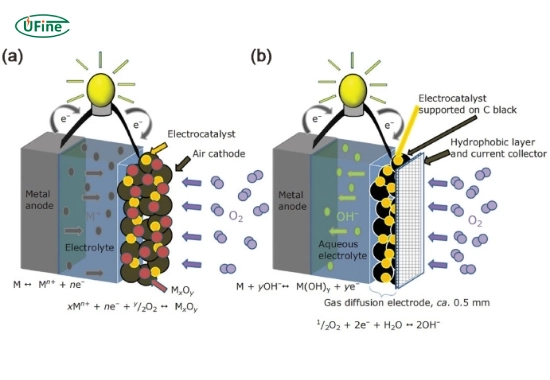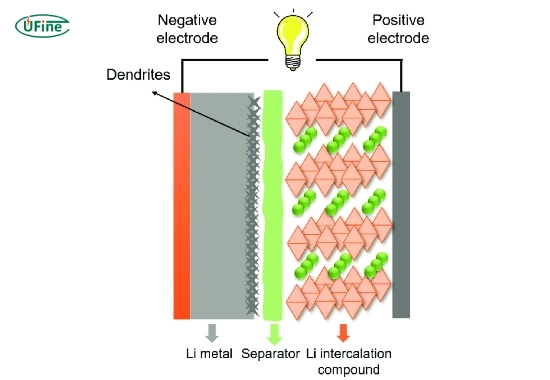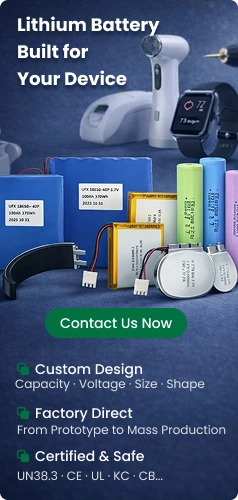
- Part 1. What is a metal air battery?
- Part 2. What is a lithium metal battery?
- Part 3. What are the main differences between metal air batteries and lithium metal batteries?
- Part 4. Advantages of metal air batteries
- Part 5. Disadvantages of metal air batteries
- Part 6. Advantages of lithium metal batteries
- Part 7. Disadvantages of lithium metal batteries
- Part 8. Applications of metal air batteries
- Part 9. Applications of lithium metal batteries
- Part 10. How do I choose between a metal air battery and a lithium metal battery?
- Part 11. FAQs
In energy storage technologies, metal air, and lithium metal batteries are gaining attention for their potential to revolutionize how we power our devices and vehicles. Understanding the differences between these two battery types is essential for making informed decisions about their applications and future developments. This article provides an in-depth analysis of metal air and lithium metal batteries, comparing their mechanisms, advantages, disadvantages, and applications.
Part 1. What is a metal air battery?
A metal air battery is an electrochemical cell that generates electricity by oxidizing a metal—most commonly zinc or aluminum—using oxygen from the atmosphere. This design allows for a significantly higher energy density than traditional batteries, making them an attractive option for various applications.
How does a metal air battery work?
The operation of a metal air battery involves several key components:
- Anode: Typically made from zinc or aluminum, the anode oxidizes during discharge, releasing electrons.
- Cathode: The cathode consists of a porous material that allows atmospheric oxygen to enter and react with the electrons released from the anode.
- Electrolyte: The electrolyte facilitates ion movement between the anode and cathode, completing the circuit.
This process generates electricity while producing byproducts such as hydroxides or carbonates.
Part 2. What is a lithium metal battery?
A lithium metal battery is another advanced type of electrochemical cell that utilizes lithium as its anode material. Unlike traditional lithium-ion batteries that use graphite for the anode, lithium metal batteries employ pure lithium, significantly enhancing energy density.
How does a lithium metal battery work?
The functioning of a lithium metal battery can be broken down into several components:
- Anode: The anode is composed of metallic lithium. During discharge, lithium ions are released into the electrolyte.
- Cathode: The cathode material can vary but often includes compounds like lithium cobalt oxide or lithium iron phosphate.
- Electrolyte: The electrolyte in these batteries is typically a lithium salt dissolved in an organic solvent, allowing for efficient ion transport.
Electricity is generated as lithium ions move from the anode to the cathode during discharge.
Part 3. What are the main differences between metal air batteries and lithium metal batteries?
Several key differences highlight their unique characteristics and performance metrics when comparing metal air and lithium metal batteries.
Energy Density
- Metal Air Batteries: These batteries can achieve energy densities of around 300–400 Wh/kg, primarily because they utilize oxygen from the atmosphere.
- Lithium Metal Batteries: They typically offer energy densities ranging from 250–350 Wh/kg, which is still impressive but generally lower than metal air batteries.
Cycle Life
- Metal Air Batteries: Generally have a shorter cycle life due to issues like corrosion and degradation during use.
- Lithium Metal Batteries: They can achieve longer lifespans than their metal air counterparts with proper design and management.
Safety
- Metal Air Batteries: While generally safe, they can face challenges related to corrosion and degradation over time.
- Lithium Metal Batteries: Safety concerns arise from dendrite formation during charging, which can lead to short circuits if not appropriately managed.
Cost
- Metal Air Batteries: The materials used (like zinc) are more abundant and cheaper than lithium, potentially lowering production costs.
- Lithium Metal Batteries: Lithium is more expensive than metals used in air batteries, impacting overall production costs.
Environmental Impact
- Metal Air Batteries: Generally considered more environmentally friendly due to the abundant materials used.
- Lithium Metal Batteries: Mining and processing lithium can have significant environmental consequences if not managed sustainably.
| Feature | Metal Air Battery | Lithium Metal Battery |
|---|---|---|
| Energy Density | 300–400 Wh/kg | 250–350 Wh/kg |
| Cycle Life | Shorter | Longer |
| Safety | Generally safe | Risk of dendrite formation |
| Cost | Lower (zinc/aluminum) | Higher (lithium) |
| Environmental Impact | More sustainable | Mining impacts |
Part 4. Advantages of metal air batteries
Metal air batteries come with several notable advantages:
- High Energy Density: Their ability to utilize atmospheric oxygen allows for higher energy storage capabilities than traditional battery technologies.
- Lightweight Design: These batteries are generally lighter than their lithium counterparts due to their more straightforward construction and use of abundant materials like zinc or aluminum.
- Cost-effective Materials: Metals like zinc are more abundant and cheaper than lithium, potentially lowering production costs significantly.
Part 5. Disadvantages of metal air batteries
Despite their benefits, metal air batteries face some challenges:
- Limited Cycle Life: They typically have shorter lifespans than lithium-based systems due to corrosion and degradation over time.
- Air Exposure Issues: The need for oxygen from the atmosphere can lead to complications in sealed environments or during transportation.
- Complexity in Design: Creating efficient designs that maximize performance while minimizing degradation can be challenging for manufacturers.
Part 6. Advantages of lithium metal batteries
Lithium metal batteries also present several advantages:
- High Energy Density: They offer substantial energy storage capabilities suitable for long-lasting power applications.
- Longer Cycle Life: With proper design and management, these batteries can achieve longer lifespans than metal-air variants.
- Rapid Charging Capabilities: Due to their unique structure, lithium metal batteries can often be charged more quickly than traditional lithium-ion systems.
Part 7. Disadvantages of lithium metal batteries
However, there are drawbacks associated with lithium metal batteries:
- Safety Concerns: Metallic lithium poses risks such as dendrite formation, which can lead to short circuits and fires if not appropriately managed.
- Cost Factors: Lithium is more expensive than metals used in air batteries, impacting overall production costs significantly.
- Environmental Impact Issues: Mining and processing lithium can have significant ecological consequences if not conducted sustainably.
Part 8. Applications of metal air batteries
Metal air batteries find use in various applications:
- Electric Vehicles (EVs): Their high energy density makes them suitable for powering electric vehicles over long distances.
- Portable Electronics: These batteries could benefit devices like smartphones and laptops by providing lighter, longer-lasting power sources.
- Grid Storage Solutions : They can be utilized in renewable energy systems to store excess power generated during peak production times.
Part 9. Applications of lithium metal batteries
Lithium metal batteries are also versatile in their applications:
- Electric Vehicles (EVs): Their high performance makes them ideal candidates for next-generation electric cars that require efficient power sources.
- Consumer Electronics: Laptops and smartphones increasingly rely on these batteries for extended usage without frequent recharging cycles.
- Aerospace Applications: Their lightweight nature and high energy density make them suitable for aerospace technologies where weight is critical for performance.
Part 10. How do I choose between a metal air battery and a lithium metal battery?
Choosing between a metal air battery and a lithium metal battery depends on several factors:
- Application Requirements: Consider what you need the battery for—if you require lightweight solutions with high energy density for portable devices or electric vehicles, both types may suit your needs but with different trade-offs.
- Cost Considerations: If budget constraints are significant, you may lean towards metal air batteries due to lower material costs; however, consider long-term performance versus initial investment.
- Safety Factors: Evaluate safety needs based on your application. If safety is paramount (e.g., in consumer electronics), you might prefer well-designed lithium systems over less stable alternatives.
- Environmental Impact Preferences: If sustainability is important to you or your organization, consider opting for more environmentally friendly options like zinc-based metal air systems.
- Longevity Needs: Assess how long you need the battery to last—if longevity is crucial (e.g., in electric vehicles), you may prefer investing in advanced lithium technologies that offer longer cycle lives despite higher upfront costs.
Part 11. FAQs
-
What are some innovative uses for metal air batteries?
Due to their high energy density and lightweight design, metal air batteries are being explored for applications in renewable energy storage systems and backup power supplies. -
How do advancements in technology affect these types of batteries?
Ongoing research aims to improve efficiency, safety features, and overall performance metrics, which could make both types more viable across various industries. -
Are there any hybrid technologies combining both types?
Yes! Researchers are investigating hybrid systems that leverage the strengths of both battery types to create more efficient energy storage solutions tailored for specific applications. -
What role do regulations play in battery technology development?
Regulations regarding environmental impact and safety standards significantly influence research directions as manufacturers strive to meet compliance while innovating new products. -
How do consumer preferences shape future developments in battery technology?
As consumers increasingly demand longer-lasting, safer, and environmentally friendly options, manufacturers must adapt their designs accordingly, driving advancements in metal air and lithium technologies.
Related Tags:
More Articles

Lithium-Ion vs Lead-Acid AMR & AGV Batteries Compared
Discover the pros and cons of lithium-ion and lead-acid AMR & AGV batteries. Learn about cost, lifespan, safety, and which is right for your fleet.
Robot Vacuum Battery Replacement: Easy Step-by-Step Guide
Learn how to replace a robot vacuum battery safely and easily. Step-by-step instructions, battery types, costs, and common mistakes to avoid.
Discover how to choose the right battery for your robot. Compare Li-ion, LiFePO₄, NiMH, and more for performance, safety, and cost.
Inside Humanoid Robot Battery Pack Design
A deep dive into humanoid robot battery pack design, covering battery life, voltage, capacity, safety, and real-world engineering trade-offs.
Humanoid Robot Battery Life: How Long Do They Really Last?
Most humanoid robots run 1.5–4 hours per charge. Learn real-world battery life, battery types, capacity limits, and future improvements.




